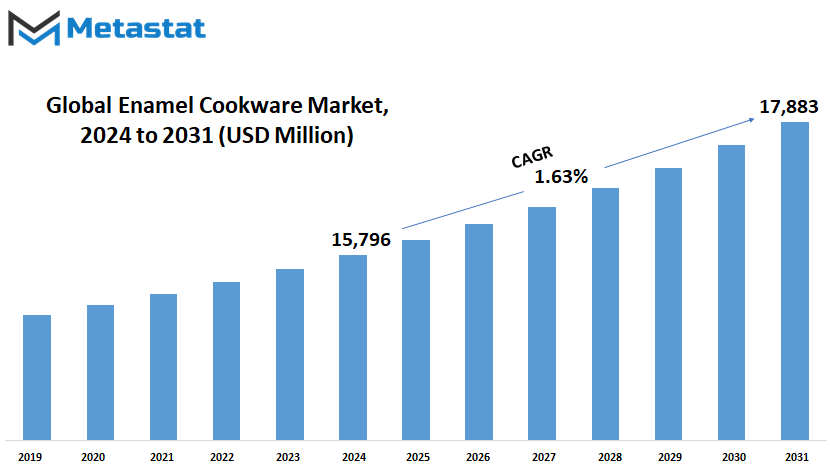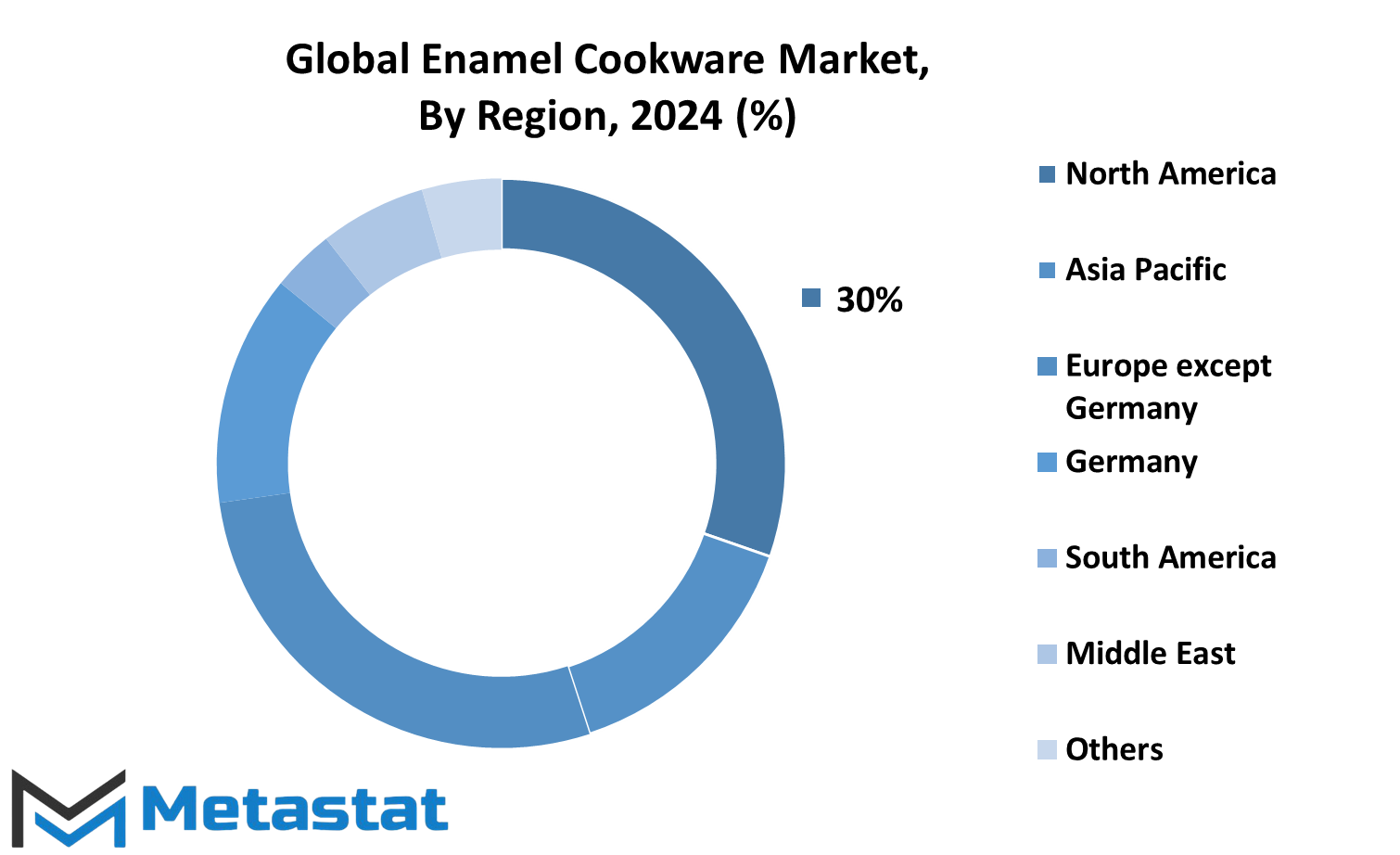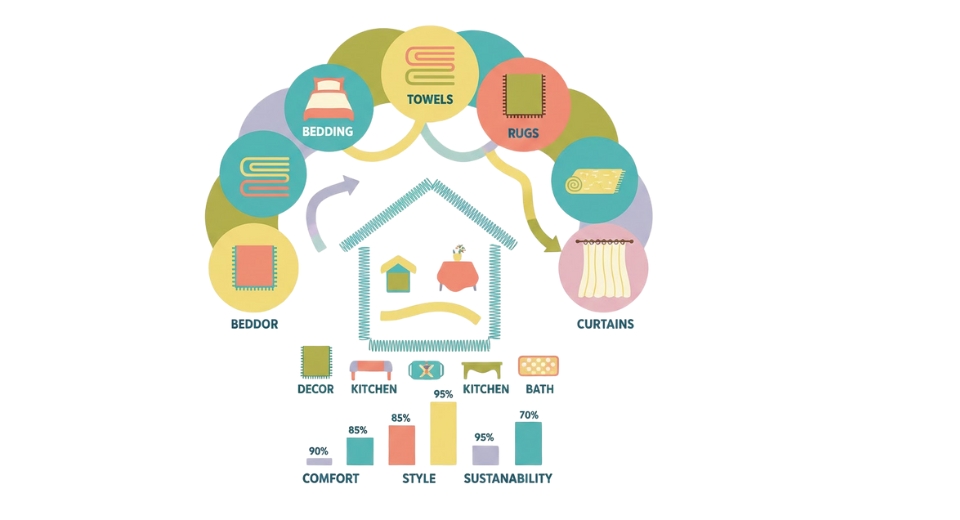MARKET OVERVIEW
The Global Enamel Cookware market has emerged to be an exciting segment within the kitchenware industry due to its strong portrayal of both tradition and modernity in its products. The dual factors that attract consumers worldwide to enamel cookware are vibrancy in color and durability, which represents a perfect blend of functionality with style. It is a market that has undergone extensive growth due to increased demands received from end-users for long-lasting and high-quality kitchen utensils, which have also become stylish and fashionable kitchenware accessories.
Enamel cookware—one that coats a metal surface with a layer of vitreous enamel—confers several advantages, which include resistance to rust, non-reactivity to acidic types of foods, and cleanability. It is for these reasons that professional and home chefs prefer it for cooking. From cookware lines such as pots, pans, or Dutch ovens to baking dishes, each type caters to a different need when cooking, thus making the enamel cookware very versatile to add to your kitchen arsenal.
There is more allure to enamel cookware than just the functional advantages it offers. It is colorful and gives your kitchen an aesthetic appeal, therefore very endearing to those wanting to give their kitchen a touch of class. This aesthetic appeal was further heightened when manufacturers of cookware were paired with some famous designers, resulting in limited-edition pieces that were as much statements of style as they were a cook's tool.
Consumer awareness of health and sustainability in recent years has driven the enamel cookware market. The non-toxic nature of enamel cookware, free from hazardous chemicals such as PFOA and PTFE, makes it a much healthier option as opposed to some non-stick alternatives. It is durable and so does not need frequent replacements, therefore fitting into the increased consumer preference for sustainable and environment-friendly products.
The popularity of enamel cookware is widespread, covering every region, thus making it a global market. While North America and Europe present demand for high-end, premium brands of enamel cookware with emphasis on quality and design, the Asia-Pacific and other emerging markets are characterized by affordable but durable options to meet the middle class's growing interest in culinary pursuits.
Improvements in technology and new methods of manufacture will decide the future of the Global Enamel Cookware market. Many companies are investing in research and development regarding enamel coatings, which are resistant to chip and scratch and provide better heat retention. Such innovations are most likely to attract consumer interest and further expand the market.
Online retailing has been very instrumental in the distribution and visibility of enamel cookware products. The e-commerce marketplace provides consumers with a wide range of brands and styles, customer reviews, and ratings that help in making informed decisions. Added to this is the convenience of online shopping, combined with well-planned digital marketing campaigns, which has enabled a manufacturer of enamel cookware to reach people.
With factors like the soaring popularity of home cooking, increasing interest in culinary television shows, and social media food trends, the enamel cookware market worldwide would most likely see continued growth. Enamel cookware should be very well positioned to meet consumers who have become more and more discerning about kitchenware, looking for a combination of both form and function.
The Global Enamel Cookware market is dynamic and growing, marrying durability and aesthetic appeal with an added health benefits enrichment within the Kitchenware industry. On its way forward, further innovation will raise, even more, consumer engagement and hold its place in kitchens worldwide.
Global Enamel Cookware market is estimated to reach $17,883 Million by 2031; growing at a CAGR of 1.63% from 2024 to 2031.

GROWTH FACTORS
The Global Enamel Cookware market is growing with a variety of support reasons. The prime reason lies with the elevation of disposable income across the world. In such a scenario, when the customer has more money to spend, he looks for an improved standard of living, and one new way to do this is investing in high-quality cookware.
Changing consumer lifestyle is another factor enabling the enamel cookware market to grow. Busy schedules require most people to go for cookware that is easy to use and clean. Enamel cookware precisely adds up to these, emphasizing durability, non-stick, and low-maintenance characteristics.
Demand for enamel-based cookware is not only on the basis of changing lifestyles but rising health consciousness as well. Recently, consumers became health conscious about the possible risks of using some types of cookware made of Teflon or aluminum. Enamel cookware is considered safe and non-toxic, hence is much in demand among health-conscious people.
However, besides all the benefits that enamelware is to avail, some of the disadvantages are likely to curb the market for growth. One of the main problems is the possible chipping or cracking of the enamel coating in the case of heavy use or neglect. Also, it is one of its drawbacks—enamel cookware has relatively low temperature tolerance in comparison to other cookware materials, which can be a drawback when applying some cooking methods.
However, growth opportunities are there in the enamel cookware market, especially with the rise of eco-friendly products. With an increasing consumer affinity toward sustainable, eco-friendly options, products are now making an increasing impact in the cookware sector with the usage of natural elements like iron and glass. Manufacturers can now sharpen their attention toward this promising market by emphasizing eco-friendly practice and showing how sustainability is achieved by utilizing their products to enjoy higher growth.
The global enamel cookware market is poised to increase tremendously at a very high rate, driven by factors such as improved disposable income, change in lifestyle, and increased health awareness. Some potential challenges are to manage if one runs a business, including the chipping and cracking risk and low heat tolerance, there are also opportunities for growth—most notably through eco-friendly practices. Focus on such avenues would put manufacturers on the vantage side of success in the coming years.
MARKET SEGMENTATION
By Product
The global enamel cookware market is showing positive growth with very many products catering to various cooking purposes. Many categories are dividing the market according to the product type, such as pots, pans, Dutch ovens, baking dishes, and others.
Most kitchens have pots, which are the tools used in boiling, simmering, and stewing. They are available in many sizes to allow for recipes that are actually prepared and the number of people to be served. Meanwhile, pans are for frying, sautéing, and searing. Due to their flat bottoms and a wider surface affording more heat conduction, food is easily cooked evenly in them.
Dutch ovens with thick walls and with lids that fit tight enough are good for simmering, braising, and roasting. Locking sufficient heat and moisture inside the cooking vessel, it turns tough meat into a tender and tasty dish. Baking dishes - from cake pans to casserole dishes, sweet and savory dishes come alive when baked. They are made in different shapes and sizes to suit various recipes.
Special enamel cookware provides, of course, specific items: griddles for the best pancakes and burgers served with grilled sandwiches; woks are recommended for stir-frying and deep-frying Asian cuisine. Roasting pans in heavy gauge metal construction and roomy volume are needed for perfectly cooking roasts, meat, and vegetables.
The market for enamel cookware will be optimistic about the future, as evolving materials and technologies increase product quality and performance. With this rise, the manufacturer will probably put efforts into research and development to come up with innovative designs meeting the demand for convenience, durability, and sustainability.
Such technological innovations as non-stick coatings and materials compatible with induction cooking will greatly enhance the efficiency of cooking and ease of cleaning. It will have a perceived added advantage in environment-related quests, such as usage of recycled materials and reduction in carbon footprint, which can attract environmentally conscious consumers.
Furthermore, the growing popularity of in-home cooking and culinary experiences is going to drive better kitchenware that shall exemplify cooking results effectively. After all, consumers are also looking at cookware not to impress friends by style but to get good cooking results.
The enamel cookware market is increasing in the world due to growing product varieties in reflection of different cooking requirements. The market is going to continue changing with technological improvements and consumer preferences adapting to convenience and sustainability, therefore offering innovative and eco-friendly cookware solutions for modern kitchens.
By Application
In the existing dynamic world market, the Enamel Cookware industry represents timelessness in traditional cooking techniques. With culinary lovers across the world still in love with the very characteristic of enamel coated cookware, Global Enamel Cookware is going to grow and diversify exponentially.
One of the chief drivers is the increasing demand for handy, healthy cooking solutions. As consumers are becoming more and more health- and environmentally conscious, they seek substitutes for traditional, occasionally harmful non-stick coatings. Enamel-coated cookware gives a safe, long-lasting solution without the hazards posed by other materials.
Besides, the versatility of enamel cookware makes it very alluring to both residential and commercial settings. In residential terms, people appreciate its even heat conduction, which delivers a perfectly cooked meal every time. From simmering soup to searing meat, enamel cookware performs consistently—something home chefs can depend on.
Enamel cookware is regarded as a mainstay of commercial kitchens, offering reasons such as durability and cleanability. Enamel pots and pans, hence, from high-volume eateries down to busy catering outfits, stand daily loads placed on them by professionals without losing their ease of cleaning and servicing. This makes them, in themselves, very cost-effective investments for businesses eyeing ways to make operations much easier without giving up on the quality of their service.
We will also see a rise in demand for enamel-coated bakeware and other kitchen gadgets, besides desperate cookware on the stovetop. Things like home baking would want consumers to seek stronger and more versatile implements to help them have professional results at home.
By Distribution Channel This report segments the global enamel cookware market by distribution channel into online and offline channels. It indicates the different channels through which consumers receive enamel cookware products worldwide.
Online distribution channels are internet-accessible platforms, such as e-commerce websites and online marketplaces. These portals make it very easy for consumers to shop from the comfort of their own homes, viewing and buying enamel cookware. Hence, these will show an increasing prominence in the distribution of enamel cookware with the rise of digitalization and technological advancement.
In contrast, offline distribution channels encompass physical retail shops. Traditional channels allow consumers to have an opportunity to see, touch, and feel before they buy the product. Despite the increasing presence of online shopping, offline channels would still be crucial to consumers either preferring to have a 'touch and feel' experience or looking for immediate gratification connected with the actual purchase.
Distribution channels for enamel cookware thus greatly form the means through which target consumers can be reached and the selling of such cookware can be increased. Each of these channels has different advantages and caters to various consumer preferences and buyer behavior.
The online channel is convenient, as a consumer can shop from anywhere, at any time, and from any device. Besides, more often than not, the online sales platforms provide a large variety of enamel cookware products at competitive pricing with convenient options for delivery, thereby enriching the shopping experience.
The other side is the benefit of touching and observation of the same by consumers through offline channels. Only this way are the users inclined to engage themselves with products through touching. Physical stores allow for product demos and customer assistance, even personalized solutions, which are more likely to drive purchase decisions.
REGIONAL ANALYSIS
The reports on the world Enamel Cookware market can be divided based on different regions in order to offer insights on its various dynamics that exist across the globe. These include North America, Europe, Asia-Pacific, South America, and Middle East & Africa.
North America has the United States, Canada, and Mexico. In Europe are the United Kingdom, Germany, France, Italy, and the Rest of Europe. Asia-Pacific includes India, China, Japan, South Korea, and the Rest of Asia-Pacific. South America, in turn, contains Brazil, Argentina, and the Rest of South America. Last but not least, the Middle East & Africa is further divided into GCC Countries, Egypt, South Africa, and the Rest of Middle East & Africa.
From a regional perspective, one can quickly review the Enamel Cookware market concerning various factors that are affecting demand, supply, and consumer preference. For example, the North American market is mature, so growth would likely remain stable with drivers such as rising disposable incomes and growing awareness of health patterns in cooking.
On the other hand, Asia-Pacific, with its burgeoning population and rapidly expanding middle class, is most likely to continue witnessing a good surge in demand in the Enamel Cookware sector, further supported by the growing use of modern cooking appliances and changing lifestyles. Heterogeneous culinary traditions, variation in consumer tastes, and changes in preferences—this is what the European market is characteristic of. This provides broad scope for innovation and product differentiation in enamel cookware. South America has huge potential because of its rich culinary heritage. While there could be an emerging demand for traditional enamel cookware, adoption of modern technologies of cooking would also prevail.
The Middle East & Africa region, therefore, with its growing urbanization and changing dietary habits, represents an emerging market for Enamel Cookware manufacturers. However, the market growth in these regions is under threat due to price sensitivity and competition from alternative materials.
By understanding regional nuances of the enamel cookware market, manufacturers and other stakeholders will know how to tweak their strategies to capture specific market trends and opportunities. This will bring in effectiveness with regard to catering to the existing diversified needs and preferences of consumers across different geographical regions, adding to the economy through sustainable growth and long-term market expansion.

COMPETITIVE PLAYERS
In the global enamel cookware market, there are many competitive players who are leading powerful innovation and consumer demand. Principal players play a gigantic role in reshaping the landscape of the industry and its trends. Some of the well-known brands are Le Creuset, Lodge Manufacturing, T-Fal, Oneida Limited, STP Goods, Karaca, BergHOFF, Cuisinart, Tramontina, Tefal, Zwilling J.A. Henckels, GreenPan, Rachael Ray.
All these firms are prominent companies in the Enamel Cookware segment, with each contributing different aspects of product offering and strategies. For instance, Le Creuset prides itself on producing fine-quality colored cookware that impinges upon both form and function. The US-based Lodge Manufacturing is focused on traditional cast-iron cookware targeted at people that want durability and classic style.
Meanwhile, T-Fal and Cuisinart are known to feature innovative features and state-of-the-art technologies targeted at the modern consumer in search of convenience and efficiency in their pieces of kitchenware. Oneida Limited and STP Goods make very affordable options available to shoppers on a tight budget without really compromising on quality.
Karaca, BergHOFF, and Zwilling J.A. Henckels tout their enamel cookware for craftsmanship and precision. Customers looking for these qualities in a product will gravitate to these brands that attach importance to the little things. Tramontina and GreenPan pitch sustainability and eco-friendliness, beckoning the conscious consumer searching for greener solutions.
Rachael Ray has been able to find a place within these big attires due to its bubbly, diversely designed cookware collections that inspire home cooks to unleash their culinary creativity throughout. Each of these players adds uniqueness to the market, increasing its diversity and hence its dynamism.
These competitive players will further maintain innovation and adaptability in the near future to meet consumer priorities or technology changes. Given the rapidly growing need for durable, functional, and creatively beautiful cookware, these key players are just in the condition to set the future in the Enamel Cookware industry.
Second, with globalization, competition will continue to increase and relent, and companies must be more agile and responsive to market dynamics; that can be worthwhile if done through technology or integrating consumer insight. There can also be more collaboration and strategic partnerships among the players looking to cash in on synergies and expand markets.
Of course, the competitive landscape in the global enamel cookware market is one with stiff competition and rapid innovation, fueled by its major players. Further, they will continue to adapt and evolve to provide future direction that the industry is going to take in addressing the diverse needs and preferences of consumers all over the globe.
Enamel Cookware Market Key Segments:
By Product
- Pots
- Pans
- Dutch Ovens
- Baking Dishes
- Others
By Application
- Residential
- Commercial
By Distribution Channel
- Online
- Offline
Key Global Enamel Cookware Industry Players
- Le Creuset
- Lodge Manufacturing
- T-Fal
- Oneida Limited
- STP Goods
- Karaca
- BergHOFF
- Cuisinart
- Tramontina
- Tefal
- Zwilling J.A. Henckels
- GreenPan
- Rachael Ray
WHAT REPORT PROVIDES
- Full in-depth analysis of the parent Industry
- Important changes in market and its dynamics
- Segmentation details of the market
- Former, on-going, and projected market analysis in terms of volume and value
- Assessment of niche industry developments
- Market share analysis
- Key strategies of major players
- Emerging segments and regional growth potential








 US: +1 3023308252
US: +1 3023308252






